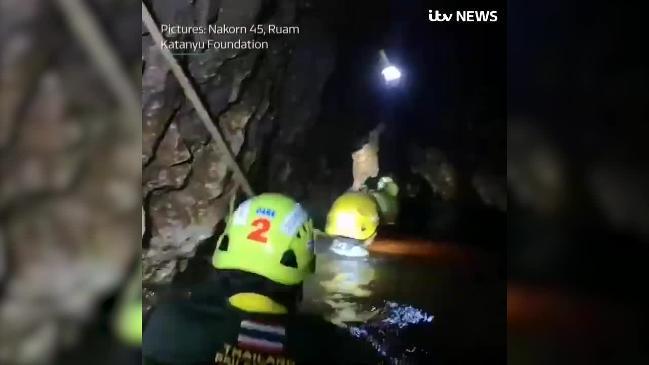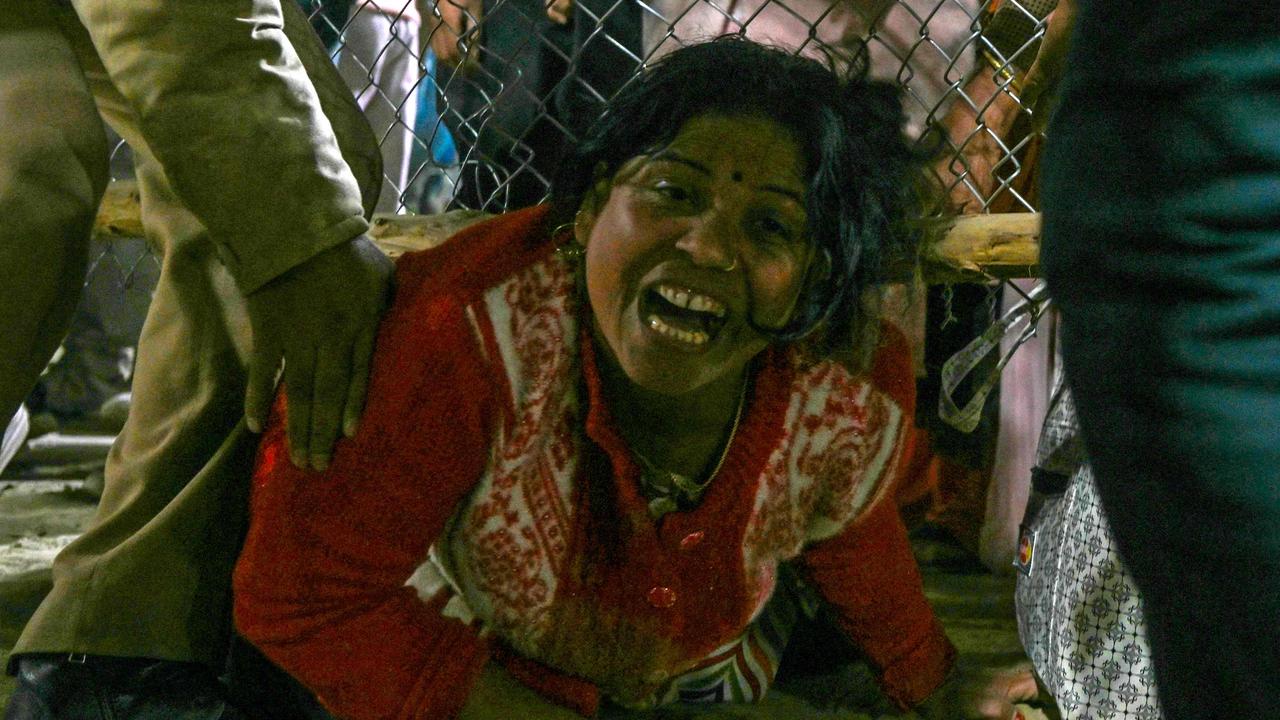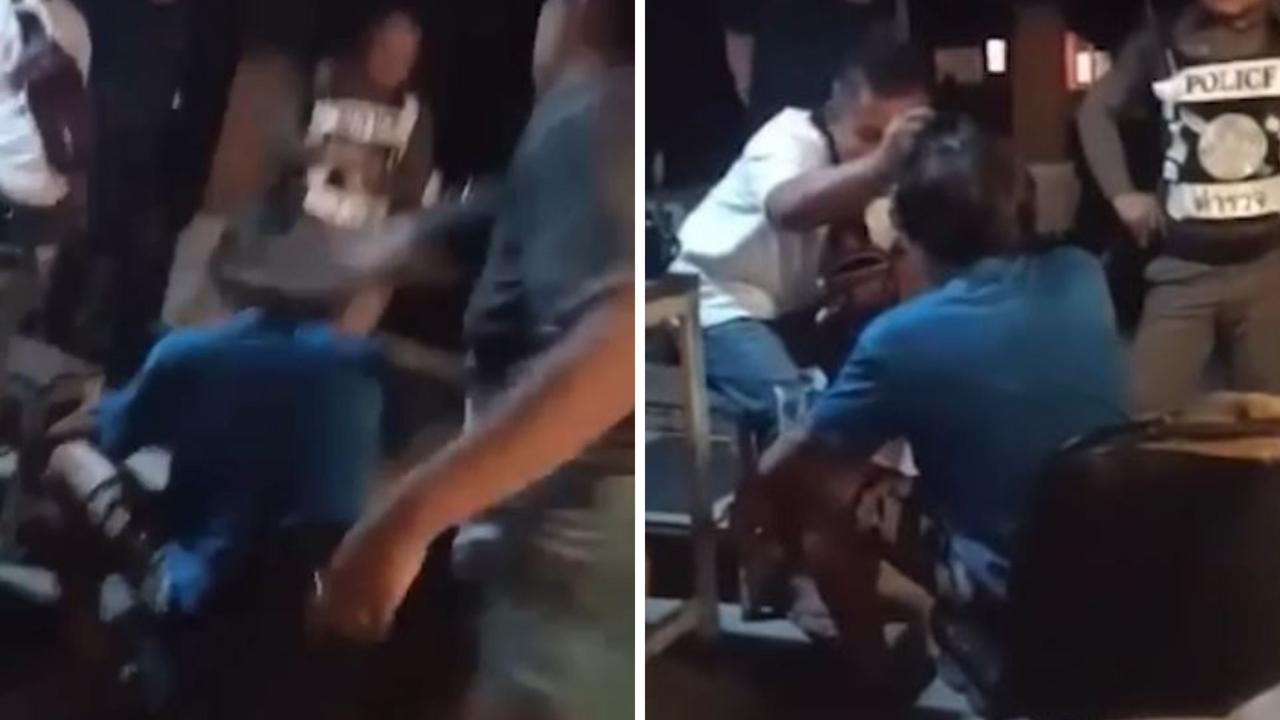Thai cave rescue: Four boys emerge after weeks trapped in dark
FOUR of the schoolboys trapped in a Thai cave have been rescued from the flooded system, but nine people remain inside.
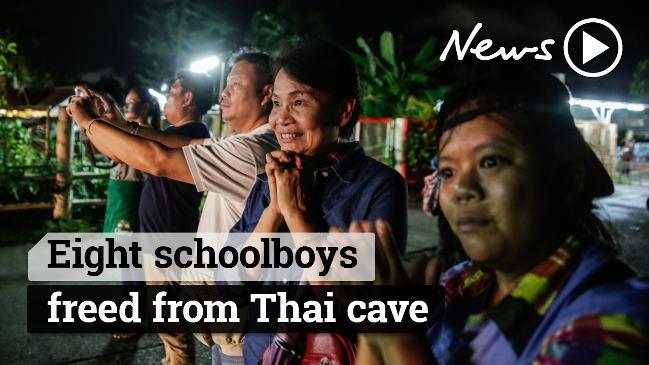
FOUR of the boys who were trapped in a flooded Thai cave system for two weeks have made it to safety after a perilous journey, but nine people remain underground.
The first two emerged from Tham Luang cave in northern Thailand at 5.40pm and 5.50pm Sunday local time (8.40pm and 8.50pm AEST), less than eight hours after the rescue began.
The third and fourth boys came out at 7.40pm and 7.50pm.
The divers hugged the young soccer players after helping them escape the dank, dark cave complex.
The boys received treatment at the scene before they were evacuated to hospital in Chiang Rai province by ambulance and helicopter.
Officials said on Sunday night that the extraordinary operation would now pause for ten to 20 hours to assess next steps, check equipment and refill oxygen tanks stationed along the dangerous route.
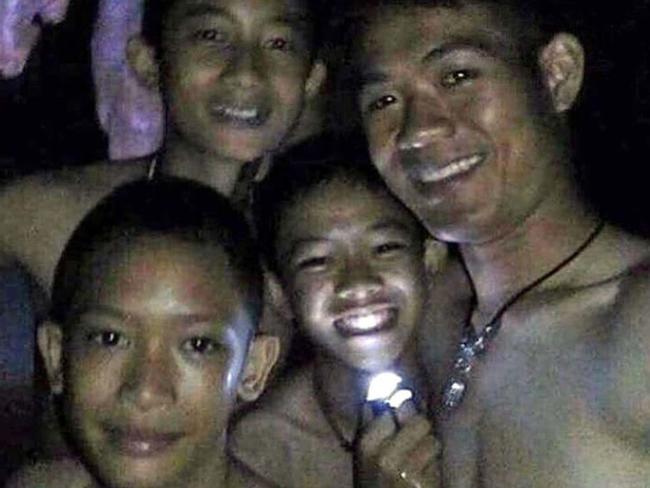
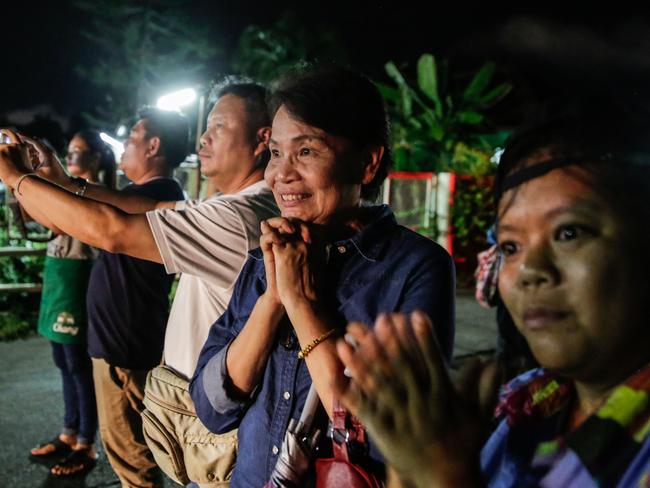
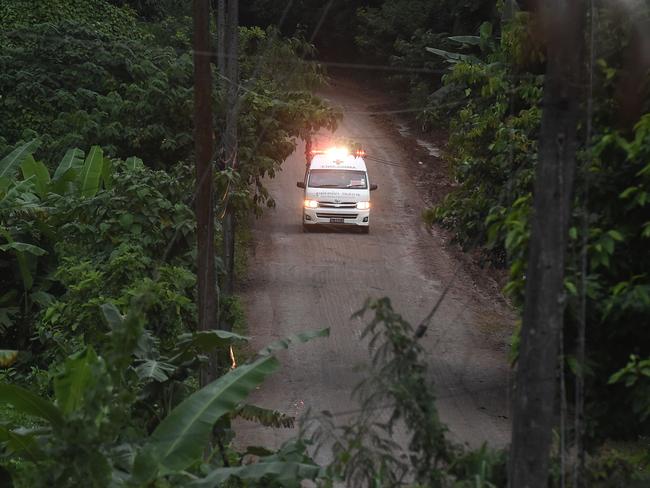

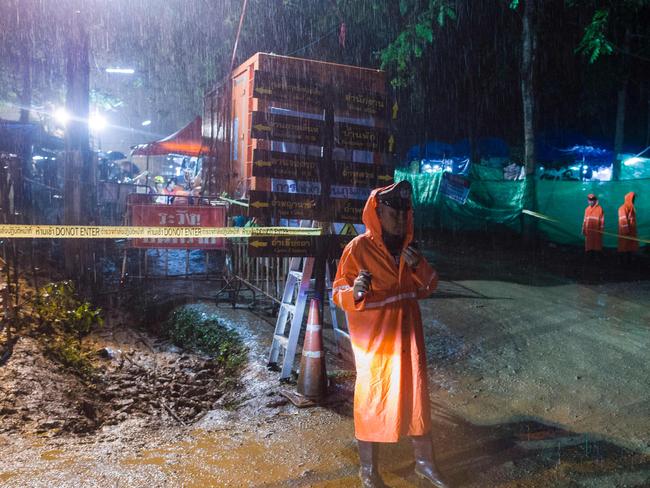
The first boy to emerge was named by local media as Mongkol Boonpium, 13, and the second as Prachuck Sutham, 14, but Chiang Rai governor Narongsak Osattanakorn would not confirm who had been rescued.
An Australian doctor’s triaging of 12 boys trapped in a cave in northern Thailand may have led to the rescue of four of the weakest children first.
The initial plan was to bring the strongest out first.
But after Adelaide cave diver and anaesthetist Richard Harris, 53, assessed the youngsters and their coach that strategy appears to have been reversed, Thai media has reported.
The 12 schoolboys, aged 11 to 16, were trapped in the cave by floodwaters on June 23, after apparently entering to scratch their names on a cave wall as part of an initiation rite.
Eight of the boys and their 25-year-old soccer coach remain there, with torrential rain pouring down on the town of Mae Sai making their rescue ever more challenging.
“Today was the best situation in terms of kids’ health, water and our rescue readiness,” said Mr Narongsak in a press conference on Sunday evening. “Four have been rescued. We consider that a great success.”
He said the first stage of the operation was finished hours earlier than expected, but warned the dangerous rescue was far from over.
“Our job is not completely done. We will have to do the next mission as successfully as the one we did today. The rest of the kids are in the same spot.
The fourth rescued boy has now arrived at the hospital. Authorities say they have to refill the the oxygen tanks stationed inside the cave before they can attempt to bring out the remaining 9 people inside—the 8 kids and their coach. Likely won’t begin until tomorrow local time pic.twitter.com/E0DbjASegU
— Matt Rivers (@MattRiversCNN) July 8, 2018
Rain now bucketing down in Mae Sai, as rescuers confirm four boys rescued but that the remaining 9 young footballers will spend another night in #thamluangcave. Next rescue ten to 20 hours away
— amanda hodge (@hodgeamanda) July 8, 2018
“Today is the day we’ve been waiting for. We are seeing the Wild Boars in the flesh nowâ€: #ThamLuang rescue chief (📹: Reuters) https://t.co/NT48w983GI pic.twitter.com/bzYf9D3Ihe
— Channel NewsAsia (@ChannelNewsAsia) July 8, 2018
The U.S. is working very closely with the Government of Thailand to help get all of the children out of the cave and to safety. Very brave and talented people!
— Donald J. Trump (@realDonaldTrump) July 8, 2018
“Air tanks and systems have to be put in place again.”
He said the rescue would resume between 7am and 5pm on Monday (11am and 9pm AEST). “I have to check all factors are stable. The operation then will be carried out.”
He said the four boys were in “perfect” health — despite earlier reports that one was being “closely monitored” — calling the rescue “our masterpiece work”.
Major General Chalongchai Chaiyakam said the extraction could take another two to four days, depending on conditions.
Rescuers smiled but did not cheer or clap as the boys emerged, their mood still “subdued” as they wait for the rest, a source at the cave entrance told Ten News reporter Daniel Sutton after media were moved back.
More than 90 international divers and 40 Thai divers have taken part in the daring rescue.
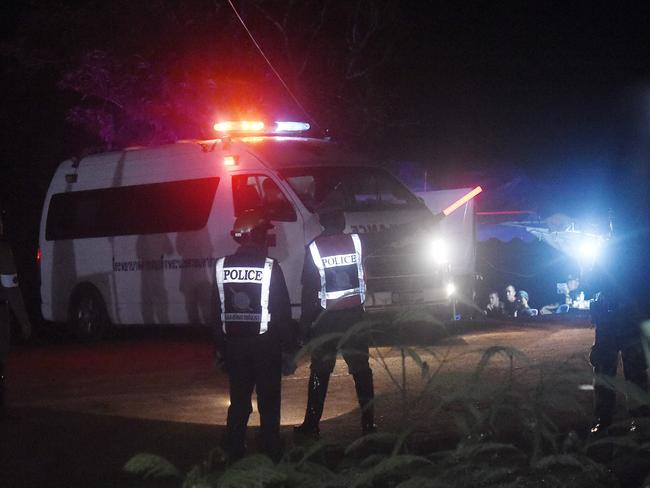
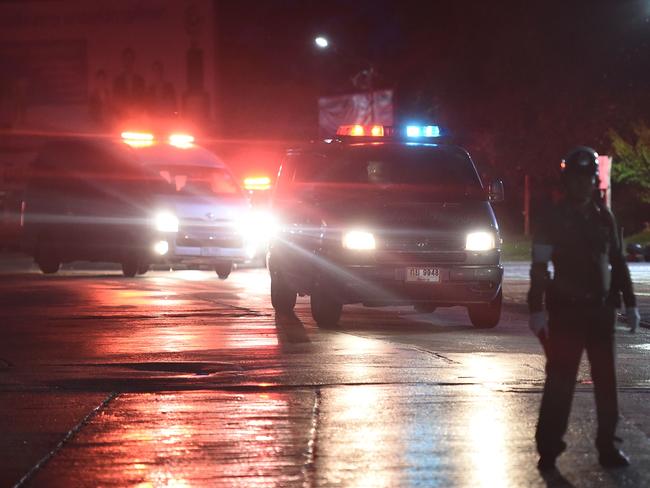
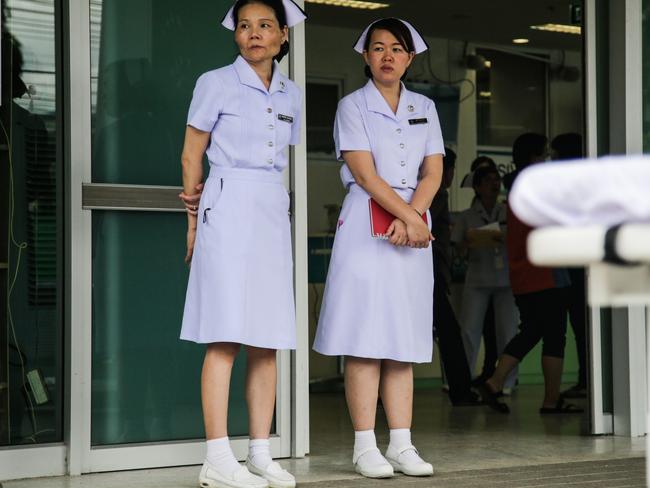
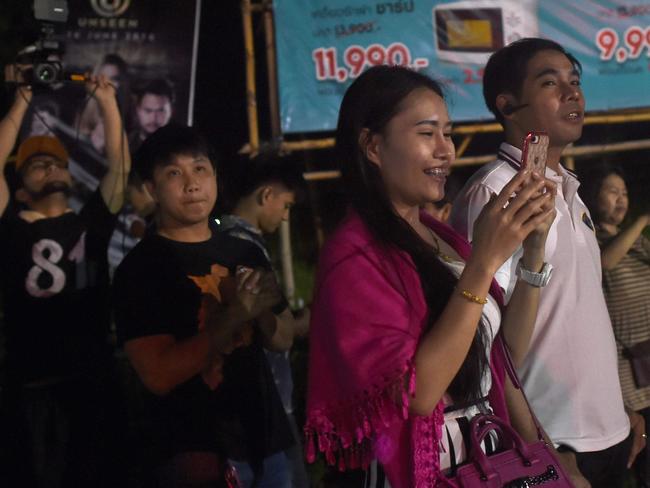
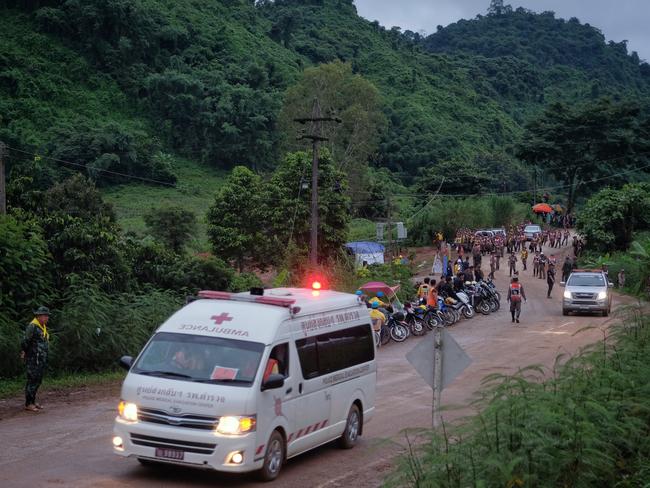
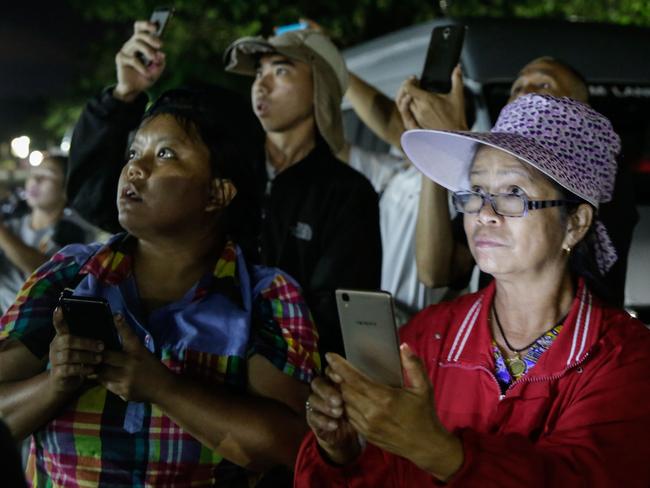
THE RESCUE
Thirteen divers entered the cave at 10am Sunday local time (1pm AEST) — some heading straight for the trapped group and others taking up stations along the three-kilometre system of flooded chambers.
Ten rescuers headed to the boys in chamber nine, and to the junction at chamber six, while the others headed to support positions shortly afterwards.
Each boy was to wear a full scuba mask, wetsuit, boots and a helmet as they were accompanied by two divers through the cave.
They were to be strapped to a “buddy”, the leading diver, by a tether and dragged along.
This diver was to carry two tanks and share oxygen with the boy as the other followed them through the cold, murky water and airless chambers that have already claimed one life.
The foreign divers and five Thai divers entered the caves after an Australian doctor gave the all-clear. Locals were required because none of the foreigners speak Thai and communication before and during the dive was key.
Additional rescue personnel, including divers from Thailand, the US, Australia, China and Europe, were stationed between the third chamber and the entrance, where the boys would have to use a rope to traverse challenging terrain.
Adelaide anaesthetist and diving expert Dr Richard Harris also joined the Thai navy.
The main difficulty during the #CaveRescue is a “choke point†at the very beginning of thier journey #13ชีวิตรà¸à¸”เเล้ว #13survivers #ThailandCaveRescue #ThamLuangRescue pic.twitter.com/Ii0p23JXwu
— Wojciech Bojanowski (@BojanowskiW) July 8, 2018
The hardest part of the mission was expected to be a 200m submerged dive. At one point, they would be confronted with the narrowest gap in the cave system — a 38cm hole in the rocks they would have to squeeze through.
One reporter on the scene described the gap as “barely bigger than a standard school ruler or the size of your head”.
Water levels inside the cave are fluctuating, making it difficult to know for sure how long some of the dives will take.
Before the Thai rescuers went in, they posted a message on the navy’s Facebook page: “We, the THAI Navy SEALS, along with the international diver team, are ready to bring the soccer team home.”
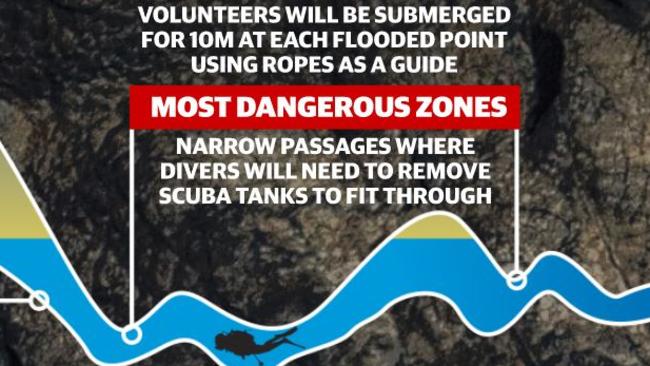
TIME IS RUNNING OUT
The boys — cold, malnourished and exhausted — have spent recent days preparing to swim through the underground maze and squeeze through the narrow choke points.
The rescue had been on hold with several suffering from exhaustion and others unable to swim, let alone dive, but the arrival of monsoon rains made it essential to begin.
The timing of the deluge could not have been worse. The mountain range above the cave, previously visible from a distance, was covered in storm clouds and impossible to see by 3.30pm. It is now officially a race against time.
Rescuers had been frantically trying to pump water out of the cave, but the assisting British Cave Rescue Council said they had “run out of time” for this option as “rain will reverse the remarkable progress made over the last few days.”
At a press conference on Sunday morning, Mr Narongsak said the boys were aware of efforts being made to rescue them but the extraction would be long and incredibly dangerous.
“Now the 13, their health and their minds are ready and they all have knowledge of the mission. They’re ready to go out,” he said. “Today is D-Day.”
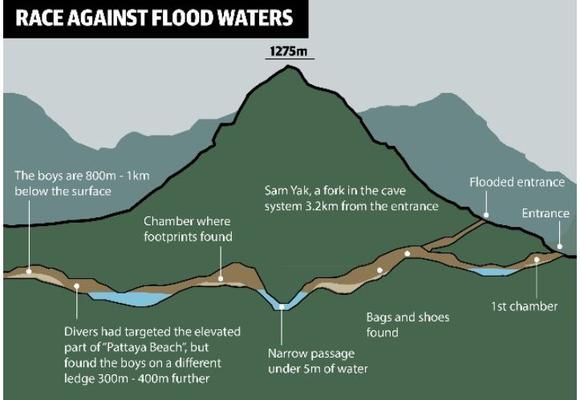
The forecast for continuing monsoonal rains and dropping oxygen levels in the cave meant the situation had become more urgent over the past 24 hours.
Shortly before the rescue operation got underway, Mr Narongsak said the health of most of the boys had “improved to normal”, and that divers were continuing to teach diving and breathing techniques.
There was great concern over the dwindling air supply as the level of oxygen in the cave where the boys are trapped dropped to 15 per cent. The usual level is around 21 per cent.
How quickly the boys are moved out will depend on the conditions and water levels inside the cave, which are likely to rise with the rain. Operations “may stop and start depending on conditions,” Mr Narongsak said.
“They can’t take them all out at once for fear of a dangerous bottleneck situation,” said CNN’s Matt Rivers, who is on the scene.
The torrential rain everyone has feared has arrived, drenching the media centre just kilometres from #Thamluangcave where a rescue mission is currently underway. pic.twitter.com/CGH8iA89vr
— amanda hodge (@hodgeamanda) July 8, 2018
It's a race against time and rain for the #Thailand cave rescue team, and the rain has begun to fall.https://t.co/bw6aIB9HUk pic.twitter.com/vuxSTOTomp
— ten daily (@tendailyau) 8 July 2018
Mountain above the cave where Thai soccer team is trapped, has almost disappeared in the rain clouds. Hoping conditions are much calmer underground @abcnews #thaicaverescue pic.twitter.com/e9vwEOROeN
— Anne Barker (@AnneABarker) July 8, 2018
He noted green netting and barricades had been erected outside the cave entrance and around a dozen additional ambulances brought in as the rescue attempt became imminent.
Journalists were asked to leave the site on Sunday morning for a new media centre set up 3km away so a rescue operation could take place.
ABC news director Gavin Morris stressed the urgency of the situation amid ominous weather reports. “The weather has clearly turned. The world is looking on anxiously,” he tweeted.
Thai divers arriving at the site. The trend towards imminent rescue attempt continues. Again, not yet confirmed. #ThaiCaveRescue pic.twitter.com/wblrhNBBbc
— Matt Rivers (@MattRiversCNN) July 8, 2018
Mr Narongsak said officials are “still at war with water and time”, after experts warned him that rain could shrink the dry ledge where the boys are sheltering to just 10 square metres.
“All the plans must not have any holes in them,” he said, noting that “hundreds of people have vetted this” and “there will always be margins for error.”
He said floodwaters had been drained as much as possible, but the rain could increase the risk. “The plan that I’ve held on to from the beginning is that we have to bring the kids out and the determining factor of this plan is to have as little water as possible.”
He also warned of higher carbon dioxide levels in the cave.
As the divers went in, it emerged that not all families had given their blessing or consent for the rescue mission to go ahead. Mr Narongsak said “they know, they understand”, according to Ten News reporter Daniel Sutton.
WHY THEY CHOSE THIS RESCUE METHOD
Various extraction methods have been proposed by experts and even Tesla boss Elon Musk, including drilling or placing the boys in nylon pods with air tanks.
With time against the rescue team as the downpour began, they were ruled out and the original plan to swim out was decided upon as the best option.
Rescuers had attempted to dig more than 100 holes, with 18 of them looking promising. But Mr Narongsak said he was not sure they could reach the boys, with the deepest reaching only 400m below the surface and the group trapped more than 600m down.
The British Cave Rescue Council said drilling would be too difficult because the equipment could not get through the dense foliage, there was no exact known target for the drill and the procedure could destabilise rocks above the children or block passages and increase flooding.
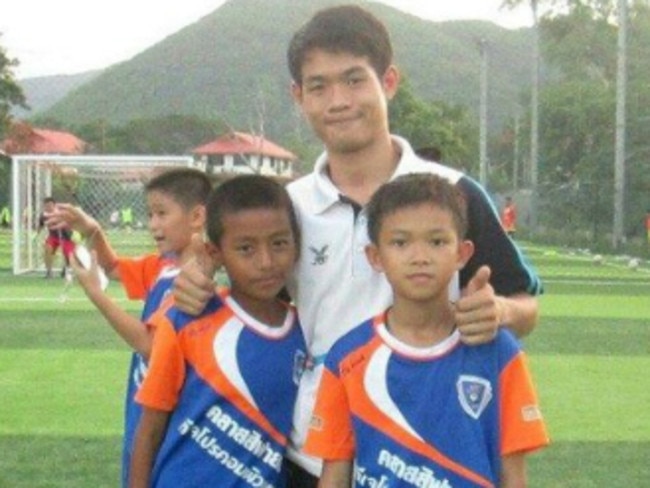
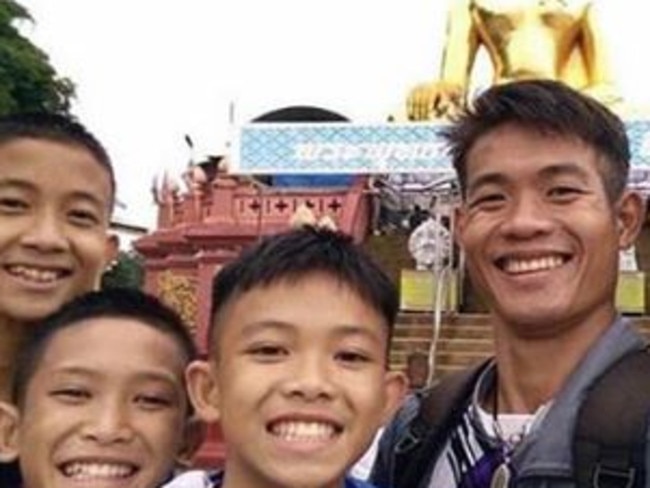
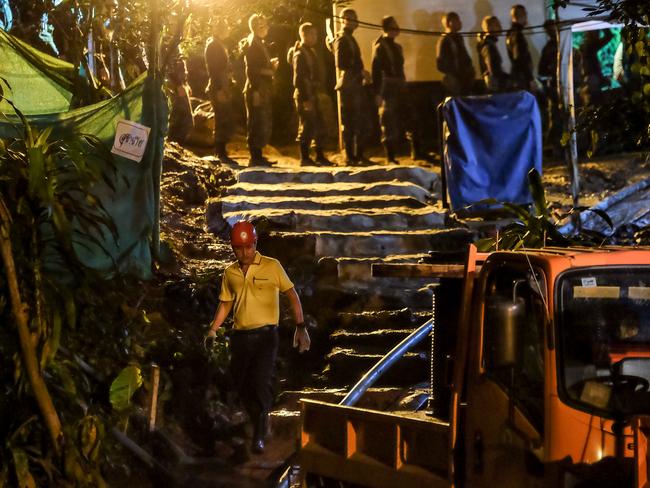
“The suggested ‘escape pipes’ could not be made sufficiently small, flexible and strong enough to withstand the passage of the children and rescuers, nor the abrasion from the sharp rock and strong currents inside the cave,” added the BCRC in a statement on Facebook.
“Sitting out the monsoon on a small, crumbling ledge with reduced oxygen and the risk of it severely flooding during the monsoon rains is no longer considered to be a viable option.
“This seems to leave the diving option as the least risky of these many uncertain options.”
Australian drilling expert Kelvin Brown, who was part of the 2010 rescue of 33 Chilean miners trapped 700m below ground, told the ABC drilling could be useful, but the situation could be different. “We knew what the formation was, we knew if there were faulted zones, the presence of aquifer,” Mr Brown said. “I’m not too sure all that information is actually at hand in this Thai scenario. But it’s all possible, as was proven.
“It makes a bit more sense to me anyway, at least for the sake of safe access, to use a drill hole.”
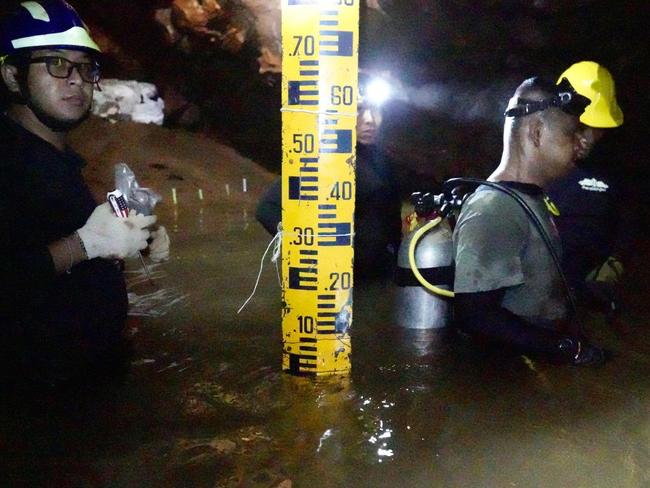
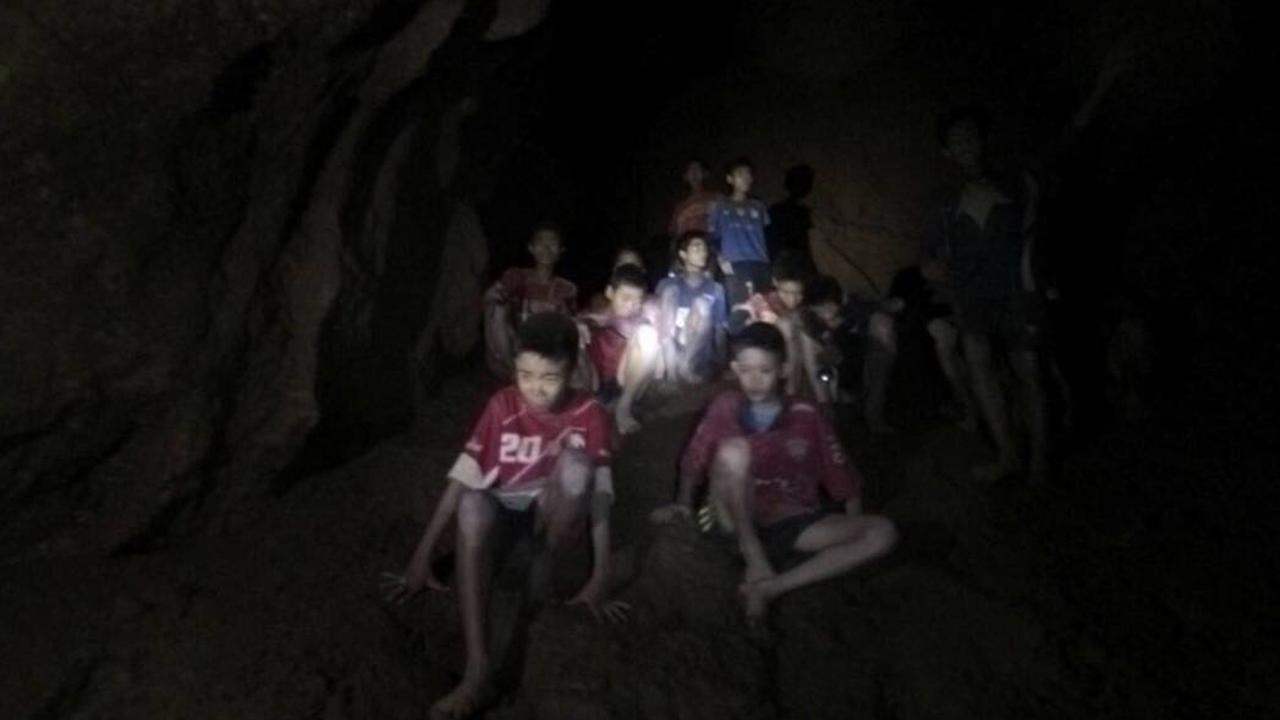
TWO WEEKS OF WAITING
The plight of the trapped group has made news around the world since they became stranded in a cramped chamber of the Tham Luang cave complex on June 23.
The 12 boys play in a local soccer team called “Wild Boars”. They were led into the partially flooded cave by their coach before a sudden downpour trapped them and were not heard from for more than a week.
British cave diving specialists found the team sheltered on a ledge nine days after they went in, dishevelled and hungry but alive.
The young soccer coach who led them inside apologised to the parents of the boys in a scrawled note released by the Thai Navy earlier this week.
“To the parents of all the kids, right now the kids are all fine, the crew are taking good care,” Ekapol Chanthawong wrote.
“I promise I will care for the kids as best as possible. I want to say thanks for all the support and I want to apologise to the parents.”
The boys also sent messages to the outside world. A total of seven pages were posted on the Thai Navy SEALs Facebook page.
Their brief notes expressed gratitude, love as well as dreams of food.
“I want to eat pan-fried pork,” one of the boys wrote.
“Don’t worry, everyone is strong”, one letter read. “When we get out of here, we want to eat many things. We want to go home as soon as possible.”
THAI CAVE CLAIMS ITS FIRST DEATH
The death of military diver Saman Kunan on Friday underscored the huge risks the boys face.
Saman was part of a team trying to establish an airline to the chamber where the children were awaiting rescue. He had placed oxygen tanks along the route but didn’t have enough air to get back to safety.
“We lost one man, but we still have faith to carry out our work,” Navy SEAL commander Apakorn vowed.


Saman resigned from the Thai military in 2006 before working at Bangkok’s Suvarnabhumi airport, according to a post on the Thai Navy SEALs Facebook page, which said he was a triathlete and a “skilled and able diver”. Thai social media filled with tributes to the fallen hero.
The diver’s death brought heartache for rescuers and anxious relatives waiting outside the Tham Luang cave in the country’s mountainous north — and raised serious doubts over the feasibility of attempting to bring a group of boys with no diving experience out through the cramped passageways.
Thailand’s Navy SEAL commander on Friday said rescuers might have little choice but to attempt the tricky extraction of the group, the first official admission that the 12 boys and their coach might not be able to wait out the monsoon underground.
“At first, we thought the children could stay for a long time … but now things have changed, we have a limited time,” Apakorn Yookongkaew told reporters.
